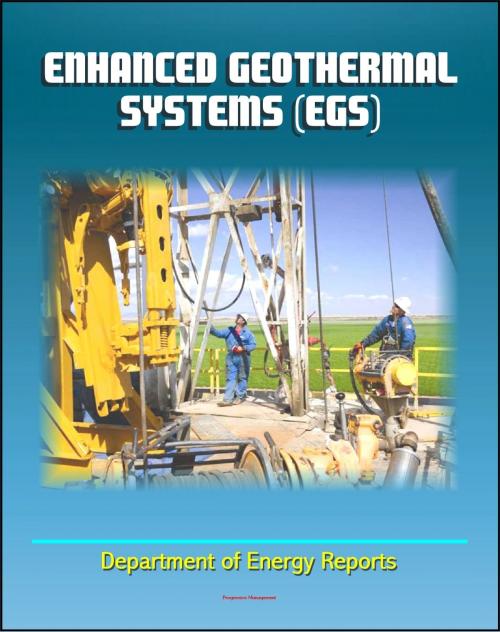Enhanced Geothermal Systems (EGS) - Basics of EGS and Technology Evaluation, Reservoir Development and Operation, Economics, Exploratory Wells
Nonfiction, Science & Nature, Technology, Power Resources| Author: | Progressive Management | ISBN: | 9781476236544 |
| Publisher: | Progressive Management | Publication: | March 15, 2012 |
| Imprint: | Smashwords Edition | Language: | English |
| Author: | Progressive Management |
| ISBN: | 9781476236544 |
| Publisher: | Progressive Management |
| Publication: | March 15, 2012 |
| Imprint: | Smashwords Edition |
| Language: | English |
Featuring Department of Energy (DOE) reports, this ebook provides comprehensive information on enhanced geothermal systems (EGS) technology.
EGS are engineered reservoirs created to produce energy from geothermal resources that are otherwise not economical due to a lack of fluid and/or permeability. EGS technology can enhance existing geothermal systems and create new systems where appropriate thermal and geologic characteristics occur. EGS has the potential for accessing the Earth's vast resources of heat located at depth to help meet the energy needs of the United States. USGS estimates 500,000 MWe of EGS geothermal resource potential lies beneath the western United States. This is approximately half of the current installed electric power generating capacity in the United States. In order to select an appropriate EGS site, it is crucial to understand the geologic characteristics of the area through field exploration. After surface exploration, an exploratory well is drilled to determine the permeability of the resource, and whether fluid is present. If the site possesses the necessary characteristics, an injection well is planned.
Geothermal energy is a domestic energy source. Clearly, geothermal energy can greatly contribute to the nation's energy mix. It is clean and available 24 hours a day. The United States has an estimated 2800 MW of geothermal installed capacity; worldwide, the figure is 8000 MW. The U.S. Geological Survey estimated in 1979 that the hydrothermal geothermal power potential in the United States was approximately 23,000 MW. In addition, thousands of installations are using geothermal energy for agriculture, aquaculture, district heating and cooling, and other direct uses. This estimate of geothermal potential could be even higher. Using geothermal energy reduces our dependence on imported fuels, creates jobs in the United States, and more favorably balances the U.S. global trading position. Geothermal energy has environmental benefits. Electricity produced from geothermal resources in the United States prevents the emission of 22 million tons of carbon dioxide, 200,000 tons of sulfur dioxide, 80,000 tons of nitrogen oxides, and 110,000 tons of particulate matter every year compared to conventional coal-fired power plants. A geothermal binary power plant, operating with a closed system, emits virtually nothing to the atmosphere. Technologies have been developed to recycle minerals contained in geothermal fluid so that little or no disposal or emissions occur.
Featuring Department of Energy (DOE) reports, this ebook provides comprehensive information on enhanced geothermal systems (EGS) technology.
EGS are engineered reservoirs created to produce energy from geothermal resources that are otherwise not economical due to a lack of fluid and/or permeability. EGS technology can enhance existing geothermal systems and create new systems where appropriate thermal and geologic characteristics occur. EGS has the potential for accessing the Earth's vast resources of heat located at depth to help meet the energy needs of the United States. USGS estimates 500,000 MWe of EGS geothermal resource potential lies beneath the western United States. This is approximately half of the current installed electric power generating capacity in the United States. In order to select an appropriate EGS site, it is crucial to understand the geologic characteristics of the area through field exploration. After surface exploration, an exploratory well is drilled to determine the permeability of the resource, and whether fluid is present. If the site possesses the necessary characteristics, an injection well is planned.
Geothermal energy is a domestic energy source. Clearly, geothermal energy can greatly contribute to the nation's energy mix. It is clean and available 24 hours a day. The United States has an estimated 2800 MW of geothermal installed capacity; worldwide, the figure is 8000 MW. The U.S. Geological Survey estimated in 1979 that the hydrothermal geothermal power potential in the United States was approximately 23,000 MW. In addition, thousands of installations are using geothermal energy for agriculture, aquaculture, district heating and cooling, and other direct uses. This estimate of geothermal potential could be even higher. Using geothermal energy reduces our dependence on imported fuels, creates jobs in the United States, and more favorably balances the U.S. global trading position. Geothermal energy has environmental benefits. Electricity produced from geothermal resources in the United States prevents the emission of 22 million tons of carbon dioxide, 200,000 tons of sulfur dioxide, 80,000 tons of nitrogen oxides, and 110,000 tons of particulate matter every year compared to conventional coal-fired power plants. A geothermal binary power plant, operating with a closed system, emits virtually nothing to the atmosphere. Technologies have been developed to recycle minerals contained in geothermal fluid so that little or no disposal or emissions occur.















